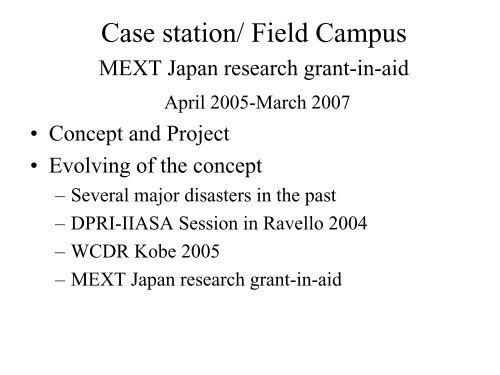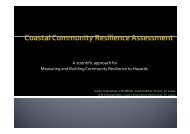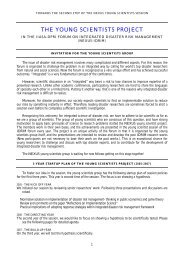3. CASiFiCA MEXT - Nexus-idrim.net
3. CASiFiCA MEXT - Nexus-idrim.net
3. CASiFiCA MEXT - Nexus-idrim.net
Create successful ePaper yourself
Turn your PDF publications into a flip-book with our unique Google optimized e-Paper software.
Case station/ Field Campus<br />
<strong>MEXT</strong> Japan research grant-in-aid<br />
April 2005-March 2007<br />
• Concept and Project<br />
• Evolving of the concept<br />
– Several major disasters in the past<br />
– DPRI-IIASA Session in Ravello 2004<br />
– WCDR Kobe 2005<br />
– <strong>MEXT</strong> Japan research grant-in-aid
What makes <strong>CASiFiCA</strong> different<br />
and unique?<br />
• Continuous monitoring (from Pre- to Post disaster time)<br />
• Cross-referencing (Multilateral Monitoring, from region to<br />
region) and Collaborative monitoring<br />
• Adaptive Management for Field-Based Disaster Research<br />
(starting from a small but testable research piece)<br />
• Time-bound (three years)<br />
• Practice-bound (Policy-makers, Practitioners, End-usersinvolved<br />
)<br />
• Benchmarking for research outcomes
Place<br />
A<br />
B<br />
C<br />
Typical Conventional Case Study Approach<br />
START END<br />
●<br />
Disaster A<br />
NO CROSS-PLACE REFERENCE<br />
retroactive<br />
non-continuity<br />
START END<br />
●<br />
Disaster B<br />
NO CROSS-PLACE<br />
REFERENCE<br />
START END<br />
●<br />
Disaster C<br />
Time
Problems in conventional<br />
disaster risk case studies<br />
• case studies focus on the past, not the<br />
present or future<br />
• isolation from both global and local<br />
communities limits contextual base and<br />
access to knowledge<br />
• are time- and location-specific
Problems in conventional disaster<br />
risk case studies (2)<br />
• ignore potential for participative approach to<br />
“social co-learning” among potential stakeholders<br />
• fail to provide for continuous monitoring as part of<br />
a proactive, anticipatory approach<br />
• identify learning points, but are not designed to<br />
convert learning to knowledge that leads to action<br />
• research driven by narrow academic agenda, not<br />
broader need for knowledge that will benefit<br />
actual communities
Place<br />
START<br />
A<br />
START<br />
B<br />
START<br />
C<br />
>>><br />
●<br />
Disaster A<br />
>>>>>>>>>>>><br />
Case Station Approach<br />
●<br />
Disaster B<br />
>>>>>>>>>>>>>>>>>>>>>><br />
●<br />
Disaster C<br />
Time<br />
CROSS-PLACE<br />
REFERENCE
Social Co-learning Process<br />
= Multilateral Knowledge Development<br />
Stakeholders<br />
Academics<br />
Time<br />
Community<br />
People<br />
Administrators<br />
NGO’s
Academic Co-learning and Life-cycle Process<br />
= Multilateral Human Resource Development<br />
Academic Agents<br />
Students (Local)<br />
Time<br />
Students (Global)<br />
Scientists (Local)<br />
Scientists (Global)<br />
(a) Students as Future Scientists<br />
(b) Students as Future Practitioners<br />
(c) Students as knowledge-carriers, spirit-holders, capacitydisseminators
Essential components of a case station<br />
Hinterland<br />
Community<br />
CASE STATION<br />
Academic institution<br />
• a degree of political / decision-making autonomy<br />
• exposure to preferably two or more natural hazards<br />
• a school<br />
• some emergency services<br />
• some planning “issues”<br />
• a medical facility (need not be a large hospital)<br />
• willingness to participate in an international project<br />
• no cash required (at the moment) – DPRI will act as<br />
secretariat<br />
• linkage to a university and/or research institution
<strong>CASiFiCA</strong>-<strong>MEXT</strong><br />
Definition and Qualification<br />
• Case station and Field campus are a set of each<br />
<strong>CASiFiCA</strong> Country sub-project.<br />
• The case station is an organ of research function.<br />
• The field campus(es) is (are) field work place where<br />
PhD and postdoc-level students work with practioners,<br />
and write a thesis, guided by (a) local supervisor(s) and<br />
international/interdisciplinary supervisor(s).<br />
• The NEXUS-IDRiM community is a primary source of<br />
international/interdisciplinary supervisor candidates.
NEXUS-IDRiM Charter<br />
Academic Initiative Network Community oriented<br />
towards Implementation Science for Integrated<br />
Disaster Risk Management (IDRiM)<br />
Whereas, the world is afflicted by continuing<br />
disasters of greater and greater severity, and<br />
Whereas, the key to reducing the impacts of disasters<br />
and advancing progress in our societies is growth<br />
and sharing of knowledge, and<br />
Whereas, the academic community is the nexus for<br />
knowledge, therefore
• We agree to launch an academic community for<br />
implementing Integrated Disaster Risk Management<br />
(IDRiM).<br />
• The community seeks to create success models for<br />
implementation of disaster science, research and<br />
education in real-world localities, varying in geographic,<br />
climatic, political, cultural and social systems.<br />
• Implementation of IDRiM should be continuously<br />
monitored, reviewed and adapted according to<br />
performance criteria.<br />
• Members enter the community on a voluntary basis,<br />
serve as individuals, and agree to commit in their own<br />
capacity to the formation and growth of the community.
• As one nexus for the community, IDRiM Forums<br />
will be held annually under DPRI-Kyoto University<br />
and IIASA initiative, with additional endorsement<br />
by host Members.<br />
• Other nexus will be case stations and field campuses<br />
for young researchers to implement IDRiM in<br />
disaster-prone regions.<br />
• General secretariat for <strong>Nexus</strong>-IDRiM will reside in<br />
the Okada laboratory of Disaster Prevention<br />
Research Institute, Kyoto University, with further<br />
assistance provided by Members to be identified.
Case Station/ Field Campus<br />
Prioritize Actions<br />
Advocates<br />
Change Agents<br />
Advocacy<br />
Motivational Tools<br />
Learning and<br />
Implementation Process<br />
Case Studies<br />
Best Practices<br />
Institution / Organization<br />
Case Station<br />
Field Campus
Year 1 (April 2005-March 2006)<br />
Budget (ca. 5.6 million yen)<br />
• Establishing the context<br />
• Brain-storming workshop<br />
• Overall framework development<br />
• Establishing of case station/ field campus<br />
• Publication
Year 2 (April 2006-March 2007)<br />
Budget 4.2 million yen<br />
• Implementing research<br />
• Exchange visits<br />
• Inter<strong>net</strong> forum<br />
• Workshops and publication
Year 3 (April 2007-March 2008)<br />
Budget <strong>3.</strong>3 million yen<br />
• Implementing research<br />
• Exchange visits<br />
• Evaluation<br />
• Symposium and publication<br />
• Future actions
Year 1<br />
• Five target case stations/ Field Campus<br />
Asian Focus<br />
– China<br />
–India<br />
– Japan<br />
–Nepal<br />
–Turkey<br />
• Other potential targets<br />
-Europe (UK?, Switzerland?,<br />
Italy?, Portugal?)<br />
-Asia (Iran?, Indonesia?)<br />
– South Africa?<br />
– South America?<br />
– North America?
Issues to Discuss<br />
- Issues related to case stations<br />
o Which case study areas?<br />
Over what period of time?: minimum three years<br />
o On which aspects of management or monitoring?<br />
o By whom?<br />
SShould be mutually beneficial<br />
-
Issues related to field campus<br />
• Research programs<br />
• Local students identified<br />
• Student exchange and international students to be<br />
sent<br />
• Research and higher education policy<br />
• Plan of action for the 1st year<br />
• Administrative issues<br />
• Financial issues
CASIFICA Matrix<br />
Station RISK<br />
Mitigation<br />
Fields<br />
Education Tools<br />
H E V<br />
S L O RT<br />
A<br />
B<br />
C<br />
D<br />
E<br />
etc<br />
H=hazard, E=Exposure, V=vulnerability<br />
S =structure, L=location, O=operation, RT=risk transfer
Which case study areas?<br />
o<br />
- Nepal: Building code implementation<br />
School safety program<br />
Hospital safety<br />
Training and teaching<br />
- India: Tsunami shelter policy<br />
Uttaranchal project / school ?<br />
Orissa community activities<br />
Gujarat reconstruction project
-<br />
Over what period of time?
On which aspects of management or<br />
monitoring?<br />
Pre-disaster mitigation<br />
Local community capacities<br />
Indigenous knowledge<br />
Local policy interventions<br />
Receptiveness<br />
Actual actions<br />
Changes in the local policies<br />
Changes in the local academic agencies
Future prospect<br />
• More grant application initiatives by other countries.<br />
• In collaboration with Kyoto University-DPRI.<br />
• From mid-term (three years) to long-term (five to ten<br />
years).<br />
• From a pilot to formal <strong>CASiFiCA</strong> enterprise.<br />
• More volunteers?<br />
• Strategic linkage to the development of the NEXUS-<br />
IDRiM.<br />
• Let us agree on our principles and framework of the<br />
<strong>CASiFiCA</strong>.








